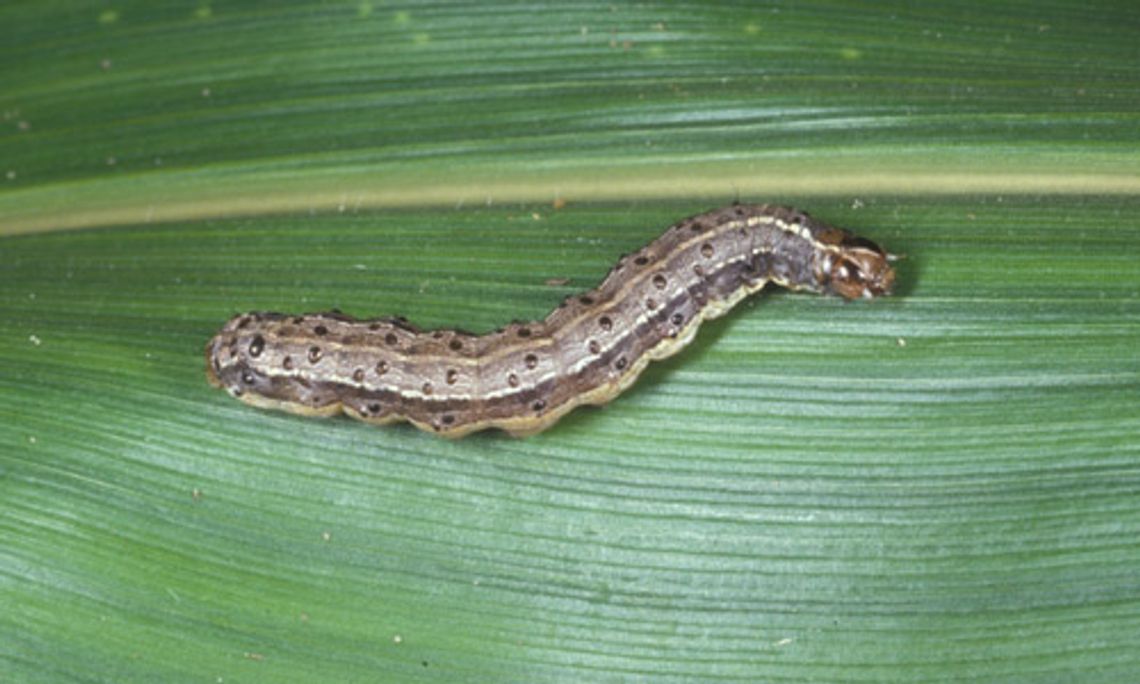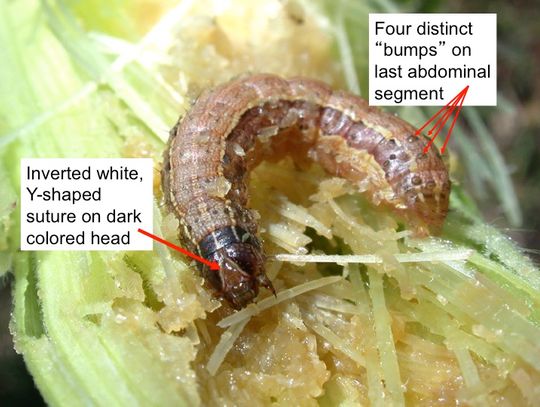
Fall armyworms are the most damaging insects of Mississippi hayfields and pastures. These caterpillars can destroy a cutting of bermudagrass in just a few days. Fall armyworms are unpredictable pests. Some years, high populations do not occur until early fall, and most heavily infested fields require only one or two sprays. Other years, damaging infestations appear as early as June, and some fields require six or more treatments.
Fall armyworms cannot survive the winter in Mississippi. Populations rebuild every year from moths that fly in from locations south of here, such as South America, the Caribbean Islands, and southern Florida. After they fly in from the south, it usually takes them a few generations to build to damaging numbers.
Fall armyworms vary in color depending on their stage of development and diet. Most are green or tan, but some can be dark brown to almost black. The body is punctuated with dark spots. Most notably, there are four spots at the rear of the body that form a square. Most caterpillars are about 1 ½ inches long. The head ranges from light brown to dark brown, and on larger caterpillars there is a distinct white inverted y-shape on the head. This white “Y” on the head and the square of four spots on the rear are two of the best ways to identify fall armyworm caterpillars.
Caterpillars take about fourteen days to complete their larval development and about a month to complete a generation, but development rates can vary depending on temperature and other factors. Like most caterpillars, fall armyworms do about 0 percent of their eating during their last two to three days as a larva—when they are “teenaged” caterpillars; therefore, if a field has reached threshold on Friday, but is not scheduled to be cut until the next week, it needs to be treated as soon as possible. A moderate to heavy population of large army worm caterpillars can eat a whole field of grass in just a couple of days. Grass that looked fine on a Friday morning, can be nothing but stems by Monday afternoon.
We wonder just how much grass a fall armyworm caterpillar can eat in its life span. In one experiment, fall armyworms ate an average of 2 square inches of crabgrass per caterpillar. That area is slightly larger than a 4 X 6 index card. In other words, a few fall armyworms caterpillars will not cause much damage, but hundreds of thousands of caterpillars per acre, can strip a field, in a matter of days.
Experienced forage producers learn to recognize the early signs of fall armyworm feeding. Newly hatched caterpillars are too small to feed all the way through the leaf blade. They begin by feeding on the underside of a leaf but leave the upper epidermis intact. This creates tiny “windowpanes” in the grass blades that appear silver and white. These windowpanes are what gives a field a frosted appearance. Recognizing this early sign of infestation can help save a cutting of hay.
The best way to avoid losing a cutting of hay to fall armyworms is to visit fields every three or four days and check for fall armyworms. Get on your hands and knees and look closely. Ruffle the grass with your fingers and count the larvae that have fallen to the ground in one square foot. Do this in several locations. Treatment is recommended when counts exceed three caterpillars that are ½ inch or longer, per square foot. We just need to sure to pay attention to pre-harvest intervals when choosing an insecticide to use on a field that is near cutting.
One option in dealing with fall armyworms in hay fields is to just go ahead and cut the hay. This can be a good choice, if the field is ready to cut and the forecast promises good hay curing weather. Be careful with this decision though. If there are a lot of big caterpillars, they will “cut the hay” for you in another couple of days. If there are threshold numbers of caterpillars, and it will be two days or more before you can cut the field, you probably need to go ahead and spray.
Over the past few years there have been significant improvements in treatment options for fall army worms. Some traditional treatment options like Sevin and Malathion are still available, but there are new treatment options that are cheaper, more effective, and have better pre-harvest intervals. These include several pyrethroid insecticides (Mustang Max, Baythroid, and Karate), as well as Tracer and Coragen and the insect growth disruptors Interpid and Demilin.
The pyrethroids insecticides are all restricted-use products, which means you must have a private applicators license to buy and use them.
By Guest Columnist Doug Carter, Rankin Cooperative Extension Service



Comment
Comments